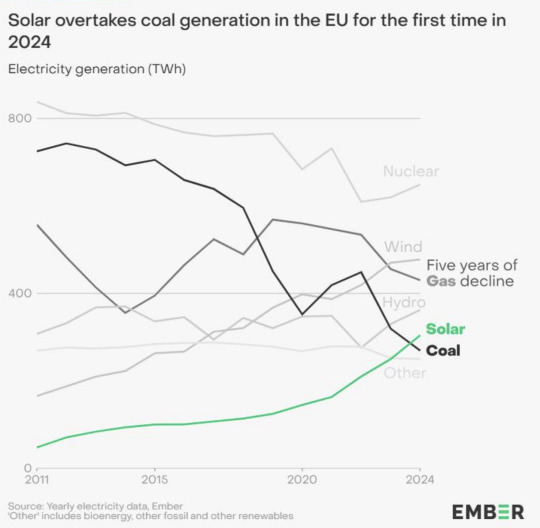#Solar power generation
Explore tagged Tumblr posts
Text




Your roof is like a miniature power station! ️
Are you still wasting free sunshine for nothing? Turn them into tangible electricity and savings!
Electricity generation for personal use, resulting in a sharp decrease in electricity bills; Green and environmentally friendly, zero carbon worry free; Stable and reliable, long-term returns; Enhance the value of houses;
Seeing is believing. Action is better than excitement!
#Solar power generation#Rooftop photovoltaics#Energy conservation and environmental protection#Smart investment#Green technology]#SMUXI
0 notes
Text
With advancements in solar power India is making significant progress, and we are witnessing tremendous growth in solar energy investment.
The installed solar power capacity growth rate nearly quadrupled from 2018 to 2021, reaching a record of over 40 gigawatts in 2021.
By 2022, the total installed solar capacity rose to around 63 gigawatts.
Contact us to learn more!
#leading solar energy company in surat#best solar panel compay in surat#solar epc company#solar epc solution provider in surat#leading solar energy company in gujarat#solar power generation#solar independent power producers in gujarat#solar power system#solar energy#solar power company#solar power company in India#solar energy solutions#solar energy company in india
0 notes
Text
タイヨウコウハツデン

太陽光発電は、太陽光エネルギーを直接電気エネルギーに変換する発電方法です。太陽電池(ソーラーパネル)を使用し、太陽光が当たると半導体内部で電子が動き出し、電気が発生する原理を利用しています。クリーンで再生可能なエネルギー源として注目されており、二酸化炭素を排出せず、環境に優しい発電方法です。太陽光パネルは屋根や屋外に設置され、発電した電気は家庭や施設で使用したり、電力会社に売電することができます。近年は技術の発展により、変換効率が向上し、様々な場所で導入が進んでいます。太陽光発電は、地球温暖化対策やエネルギー自給率の向上に貢献し、持続可能な社会の実現に向けて重要な役割を担っています。また、災害時や電源のない場所での電力供給としても期待されています。
手抜きイラスト集
#太陽光発電#Solar power generation#energia solare#energía solar#énergie solaire#Solarenergie#手抜きイラスト#Japonais#bearbench#art#artwork#illustration#painting
1 note
·
View note
Text
Solar Electric Power Generation: Sustainable Energy Solutions
Solar electric power generation has emerged as a transformative solution in the global shift towards sustainable and renewable energy. As the demand for cleaner energy grows, solar power offers an environmentally friendly alternative to fossil fuels. By converting sunlight into electricity through photovoltaic (PV) systems, solar power generation not only reduces greenhouse gas emissions but also provides energy independence and long-term cost savings.
This article explores the benefits, advancements, and importance of solar electric power generation, along with insights into its role in powering homes, businesses, and industries.
What is Solar Electric Power Generation?
Solar electric power generation refers to the process of converting sunlight into electricity using solar panels, also known as photovoltaic (PV) cells. These cells capture the sun’s rays and convert them into direct current (DC) electricity. In most modern solar systems, an inverter is then used to transform this DC electricity into alternating current (AC), which can be used to power homes, businesses, or even larger-scale operations.
How Solar Power Works
Solar power generation is based on the photovoltaic effect, a process discovered over 100 years ago. Here's a breakdown of the steps:
Solar Panels Capture Sunlight: Solar panels are composed of photovoltaic cells, usually made from silicon. When sunlight hits these cells, electrons in the silicon material become excited, initiating an electric current.
Conversion of DC to AC: The current generated is direct current (DC), but most electrical appliances and systems use alternating current (AC). An inverter is used to convert DC to AC, allowing the electricity to power homes, businesses, and even industrial facilities.
Energy Storage or Grid Integration: If the generated electricity isn’t used immediately, it can either be stored in solar batteries for later use or fed back into the electrical grid. In grid-connected systems, any surplus energy produced can be sold back to utility companies, offering additional financial benefits.
Benefits of Solar Electric Power Generation
Eco-Friendly Energy: Solar power is a clean, renewable energy source that produces no direct emissions or pollutants. By replacing traditional energy sources like coal and natural gas, solar power helps reduce global carbon footprints and combat climate change.
Cost Savings: While the initial investment in solar systems can be high, the long-term financial benefits are substantial. Solar users can significantly reduce their monthly utility bills, and in some cases, even eliminate them. Additionally, many governments offer tax incentives and rebates to encourage solar adoption, further lowering costs.
Energy Independence: Solar power allows individuals, businesses, and even entire regions to become less reliant on the conventional power grid. This energy independence is especially important for areas that experience frequent power outages or high electricity prices.
Low Maintenance: Solar panels have no moving parts, which makes them relatively low-maintenance. With proper care, they can last over 25 years. Occasional cleaning and routine checks are often enough to ensure that the system operates at peak efficiency.
Increased Property Value: Homes and businesses equipped with solar panels often see an increase in property value. Solar energy systems are considered a valuable asset, as they provide cost savings and are an attractive feature for environmentally-conscious buyers.
Key Advancements in Solar Technology
Improved Efficiency: Recent advancements in PV technology have significantly improved the efficiency of solar panels. Newer models are capable of converting more sunlight into electricity, even under low-light conditions or cloudy weather. This means that smaller and fewer panels can produce the same amount of energy as older, less efficient models.
Energy Storage Solutions: The rise of affordable and efficient energy storage solutions, such as solar batteries, has made solar power more reliable. Solar batteries store excess energy generated during the day, which can then be used during the night or on cloudy days, reducing dependency on the grid.
Smart Solar Systems: Many modern solar systems come equipped with monitoring software that allows users to track energy production and consumption in real-time. This enables homeowners and businesses to optimize their energy usage and improve overall efficiency.
BIPV (Building Integrated Photovoltaics): Solar panels can now be integrated directly into building materials such as windows, roofs, and facades. BIPV systems offer both energy generation and aesthetic appeal, blending seamlessly with the architectural design.
Solar Power for Homes and Businesses
The use of solar electric power generation for residential and commercial applications has become increasingly common. Solar power can be tailored to suit various energy needs, making it ideal for both small-scale installations and large industrial projects.
Solar Power for Homes
Homeowners across the world are turning to solar energy as a cost-effective and sustainable alternative to traditional energy sources. A solar PV system on a rooftop can supply most, if not all, of a household's energy needs. By pairing solar panels with a battery storage system, homeowners can store excess electricity for use during the night or in emergencies, further reducing their reliance on the grid.
Solar Power for Businesses
Businesses benefit from solar energy by reducing operational costs and demonstrating a commitment to sustainability. With rising energy prices, investing in solar power is a smart long-term strategy for companies looking to manage energy costs and reduce their carbon footprint. Additionally, businesses can take advantage of various tax incentives and subsidies to reduce the upfront investment in solar infrastructure.
The Role of Solar Power in Industrial Applications
Solar power is increasingly being adopted in industrial settings, where energy consumption is typically high. By integrating solar energy into manufacturing processes, companies can lower energy costs while maintaining their commitment to eco-friendly practices. Some industries have even implemented large-scale solar farms to power operations and contribute surplus energy to the grid.
Future of Solar Electric Power Generation
The future of solar electric power generation looks promising, with advancements in technology and growing awareness about the benefits of renewable energy. Innovations such as perovskite solar cells, solar roadways, and floating solar farms have the potential to revolutionize the industry further.
Governments and private entities are investing heavily in solar power infrastructure to meet increasing energy demands and reduce the global dependency on non-renewable energy sources. As costs continue to fall and efficiency improves, solar power will play a crucial role in the future of global energy supply.
Conclusion
Solar electric power generation represents a key solution in the fight against climate change and the push for sustainable energy sources. From cost savings and energy independence to environmental benefits, solar power is a game-changing technology that offers long-term advantages for homeowners, businesses, and industries alike.
At JJ Innovative Solutions, we are committed to helping you harness the power of the sun. Our comprehensive solar power services, including consultation, installation, and maintenance, are designed to meet your specific energy needs. Whether you're looking to power your home or business, our solar solutions offer a sustainable, cost-effective path toward a brighter future.
Discover the potential of solar power with JJ Innovative Solutions and make the switch to clean energy today.
#solar power energy#green power solar#solar power generation#solar power electricity#power on solar#solar power source#solar electric power generation#solar and wind power#solar production#solar energy production#solar wind power#solar energy is produced by
0 notes
Text
Renewable Energy Potential: Mapping India's Transition to a Green Future

India stands at a crucial juncture in its quest for sustainable development, marked by a significant shift towards renewable energy sources. With the pressing need to mitigate climate change and reduce dependence on fossil fuels, the country is increasingly turning to solar energy and other renewables to power its future. This transition is not merely about embracing cleaner sources of energy; it represents a fundamental restructuring of India's energy landscape, with far-reaching implications for its economy, environment, and society.
Embracing Solar Power:
Solar energy has emerged as a cornerstone of India's renewable energy strategy. Blessed with abundant sunlight throughout the year, India possesses immense solar energy potential, making it an ideal candidate for large-scale solar power generation. The government's ambitious targets, such as achieving 100 GW of solar capacity by 2022 and 450 GW by 2030, underscore its commitment to harnessing this abundant resource.
One of the most notable successes in India's solar journey has been the dramatic reduction in solar tariffs. Through competitive bidding processes and technological advancements, the cost of solar power has plummeted, making it increasingly competitive with conventional sources of energy. This cost competitiveness has not only accelerated the deployment of solar projects but has also made solar energy accessible to a wider range of consumers, including industries, commercial establishments, and households.
Beyond Solar: Diversifying the Renewable Portfolio:
While solar energy dominates discussions around India's renewable energy transition, other sources such as wind, hydro, biomass, and geothermal also play crucial roles. Wind energy, in particular, has witnessed significant growth, with India emerging as one of the world's top wind energy producers. Similarly, the untapped potential of hydroelectric power, particularly in regions like the Himalayas, presents opportunities for further expansion.
Moreover, advancements in technology and innovation are opening up new frontiers in renewable energy. From offshore wind farms to floating solar installations and innovations in energy storage, these developments are enriching India's renewable energy portfolio and enhancing its resilience against variability in weather conditions.
Policy Support and Regulatory Framework:
The success of India's energy transition hinges upon a conducive policy environment and robust regulatory frameworks. The government's flagship initiatives, such as the National Solar Mission, the Green Energy Corridor Project, and various state-level policies, provide the necessary impetus for renewable energy deployment. Furthermore, measures such as renewable purchase obligations, net metering, and fiscal incentives are incentivizing investments in clean energy projects.
However, challenges persist, including land acquisition issues, grid integration constraints, and financing hurdles. Addressing these challenges requires a coordinated effort from policymakers, industry stakeholders, and civil society to streamline processes, enhance grid infrastructure, and mobilize investments.
Socioeconomic Impacts and Opportunities:
India's transition to renewable energy is not only about reducing carbon emissions; it also holds immense socioeconomic potential. The renewable energy sector is a significant driver of job creation, offering employment opportunities across the value chain, from manufacturing and installation to operations and maintenance. Moreover, decentralized renewable energy solutions have the potential to empower rural communities by providing access to clean, reliable, and affordable energy.
Furthermore, by reducing dependence on imported fossil fuels, India's renewable energy push enhances energy security and reduces the nation's vulnerability to global energy price fluctuations. This, in turn, strengthens India's economic resilience and fosters sustainable growth.
Conclusion:
India's journey towards a green future powered by renewable energy is both promising and challenging. While significant progress has been made, much work lies ahead to realize the full potential of renewables and achieve the nation's energy transition goals. Collaboration among government, industry, academia, and civil society will be key to overcoming barriers, driving innovation, and accelerating the adoption of clean energy technologies. With steadfast commitment and collective action, India can pave the way for a sustainable, inclusive, and prosperous future powered by renewable energy.
0 notes
Text
Thin-film Amorphous Silicon Solar Cell Market Research, Analysis, Demand, Overview and Regional Outlook Study 2017 – 2032
The market for solar photovoltaic (PV) cells based on thin layers of amorphous silicon, a non-crystalline type of silicon, is known as the thin-film amorphous silicon solar cell market. In comparison to conventional crystalline silicon sun cells, these thin-film solar cells provide benefits including flexibility, light weight, and low production costs. The demand for thin-film amorphous silicon solar cells is described in the following way:
Market Overview: In recent years, the thin-film amorphous silicon solar cell market has seen rapid expansion. The market has grown as a result of the rising demand for renewable energy, improvements in thin-film solar cell technology, and the requirement for affordable solar solutions. Applications for thin-film amorphous silicon solar cells include consumer electronics, off-grid solar systems, and building-integrated photovoltaics..
Demand Drivers:
Thin-film amorphous silicon solar cell demand would be influenced by a number of variables, such as government policies and incentives encouraging the use of solar energy, advances in thin-film technology, thin-film solar cells' cost competitiveness with other solar technologies, and the expansion of the solar energy market as a whole.
1. The switch to renewable energy: It sources has raised demand for solar photovoltaic (PV) technology due to environmental concerns and the need to minimise carbon emissions. Thin-film amorphous silicon solar cells have the ability to be produced on a big scale and at a low cost, helping to meet this need.
2. Flexible and Lightweight Design: Thin-film amorphous silicon solar cells have features that make them flexible and lightweight, making them appropriate for uses where conventional rigid solar panels are impractical. The potential applications of these cells are increased by their incorporation into curved surfaces, flexible substrates, and portable devices.
3. Cost-Effective Manufacturing: The production of thin-film amorphous silicon solar cells entails depositing amorphous silicon in thin layers on a variety of substrates, including flexible materials and glass. Thin-film technology is a cost-effective alternative since this production method enables higher throughput and cheaper material costs when compared to crystalline silicon solar cells.
4. Building-Integrated Photovoltaics (BIPV): In BIPV, solar panels are integrated into building components like windows, facades, or roofing. Thin-film amorphous silicon solar cells are frequently utilised in BIPV. Solar energy production is made possible by this integration while yet keeping the beauty of the building.
5. Off-Grid and Portable Solar Systems: Thin-film amorphous silicon solar cells are suitable for off-grid and portable solar systems due to their flexibility and light weight. These cells can be deployed in rural and distant locations. These cells can be used in remote areas, rural electrification projects, camping equipment, and charging solutions for portable electronics.
In conclusion, the demand for building-integrated photovoltaics, off-grid and portable solar systems, flexibility and lightweight thin-film technology, and cost-effective manufacturing processes all contribute to the growth of the thin-film amorphous silicon solar cell market. Thin-film amorphous silicon solar cells are anticipated to play a vital role in satisfying the growing demand for clean and sustainable power generation as solar energy continues to gather momentum.
Here are some of the key benefits:
1. Cost-Effective Solar Technology: Low-cost components and production techniques can be used to create thin-film amorphous silicon solar cells.
Thin-film amorphous silicon solar cells: can be deposited on flexible substrates, making it possible to create lightweight and flexible solar panels.
3. Low-Light Performance: Amorphous silicon solar cells operate well in dimly lit regions, making them appropriate for locations with diffuse sunlight or light shade.
4. Rapid Energy Payback: When compared to other solar technologies, thin-film amorphous silicon solar cells have a comparatively quick energy payback time, which is the amount of time it takes to produce the same amount of energy that was used during manufacture.
Referrals to our Stringent datalytics company, trade journals, and websites that focus on market reports are encouraged. These sources frequently include thorough research, market trends, growth projections, competition analysis, and other insightful information about this market.
You can investigate the availability of particular reports linked to this market by going to our website or getting in touch with us directly. We offer thorough and in-depth information that might be helpful for firms, investors, and individuals interested in this industry, but these reports frequently need to be purchased or subscribed to.
“Remember to look for recent reports to ensure you have the most current and relevant information.”
Click Here, To Get Free Sample Report: https://stringentdatalytics.com/sample-request/thin-film-amorphous-silicon-solar-cell-market/10440/
Market Segmentations:
Global Thin-film Amorphous Silicon Solar Cell Market: By Company • Hanergy • Sharp Thin Film • Trony • Nexpower • GS Solar • Kaneka Solartech • Best Solar • QS Solar • T-Solar Global • Solar Frontier • Panasonic • Bosch Solar • United Solar • Kaneka • Schott Solar Global Thin-film Amorphous Silicon Solar Cell Market: By Type • Single Junction • Dual-junction • Multi-junction Global Thin-film Amorphous Silicon Solar Cell Market: By Application • Lamps • Chargers • Pest Controller • Power Stations • Curtain Wall Global Thin-film Amorphous Silicon Solar Cell Market: Regional Analysis The regional analysis of the global Thin-film Amorphous Silicon Solar Cell market provides insights into the market's performance across different regions of the world. The analysis is based on recent and future trends and includes market forecast for the prediction period. The countries covered in the regional analysis of the Thin-film Amorphous Silicon Solar Cell market report are as follows: North America: The North America region includes the U.S., Canada, and Mexico. The U.S. is the largest market for Thin-film Amorphous Silicon Solar Cell in this region, followed by Canada and Mexico. The market growth in this region is primarily driven by the presence of key market players and the increasing demand for the product. Europe: The Europe region includes Germany, France, U.K., Russia, Italy, Spain, Turkey, Netherlands, Switzerland, Belgium, and Rest of Europe. Germany is the largest market for Thin-film Amorphous Silicon Solar Cell in this region, followed by the U.K. and France. The market growth in this region is driven by the increasing demand for the product in the automotive and aerospace sectors. Asia-Pacific: The Asia-Pacific region includes Singapore, Malaysia, Australia, Thailand, Indonesia, Philippines, China, Japan, India, South Korea, and Rest of Asia-Pacific. China is the largest market for Thin-film Amorphous Silicon Solar Cell in this region, followed by Japan and India. The market growth in this region is driven by the increasing adoption of the product in various end-use industries, such as automotive, aerospace, and construction. Middle East and Africa: The Middle East and Africa region includes Saudi Arabia, U.A.E, South Africa, Egypt, Israel, and Rest of Middle East and Africa. The market growth in this region is driven by the increasing demand for the product in the aerospace and defense sectors. South America: The South America region includes Argentina, Brazil, and Rest of South America. Brazil is the largest market for Thin-film Amorphous Silicon Solar Cell in this region, followed by Argentina. The market growth in this region is primarily driven by the increasing demand for the product in the automotive sector.
Visit Report Page for More Details: https://stringentdatalytics.com/reports/thin-film-amorphous-silicon-solar-cell-market/10440/
Reasons to Purchase Thin-film Amorphous Silicon Solar Cell Market Report::
• To obtain insights into industry trends and dynamics, including market size, growth rates, and important factors and difficulties. This study offers insightful information on these topics.
• To identify important participants and rivals: This research studies can assist companies in identifying key participants and rivals in their sector, along with their market share, business plans, and strengths and weaknesses.
• To comprehend consumer behaviour: these research studies can offer insightful information about customer behaviour, including preferences, spending patterns, and demographics.
• To assess market opportunities: These research studies can aid companies in assessing market chances, such as prospective new goods or services, fresh markets, and new trends.
In general, market research studies offer companies and organisations useful data that can aid in making decisions and maintaining competitiveness in their industry. They can offer a strong basis for decision-making, strategy formulation, and company planning.
About US:
Stringent Datalytics offers both custom and syndicated market research reports. Custom market research reports are tailored to a specific client's needs and requirements. These reports provide unique insights into a particular industry or market segment and can help businesses make informed decisions about their strategies and operations.
Syndicated market research reports, on the other hand, are pre-existing reports that are available for purchase by multiple clients. These reports are often produced on a regular basis, such as annually or quarterly, and cover a broad range of industries and market segments. Syndicated reports provide clients with insights into industry trends, market sizes, and competitive landscapes. By offering both custom and syndicated reports, Stringent Datalytics can provide clients with a range of market research solutions that can be customized to their specific needs
Contact US:
Stringent Datalytics
Contact No - +1 346 666 6655
Email Id - [email protected]
Web - https://stringentdatalytics.com/
#Thin-film Amorphous Silicon Solar Cell#Solar Energy#Photovoltaics#Renewable Energy#Solar Cell Technology#Energy Efficiency#Thin-film Solar Panels#Amorphous Silicon Technology#Alternative Energy#Solar Power Generation#Sustainable Energy#Energy Conversion#Solar Panel Efficiency#Green Technology#Solar Energy Harvesting#Clean Energy#Solar Cell Manufacturing#Solar Energy Innovation#Photovoltaic Modules#Thin-film PV#Solar Electricity.#global market report#global market insights
0 notes
Text
Popular understanding of military technologies and capabilities is weirdly frozen in like, WWII and the cold war, even with the incredibly televisied bombing of Baghdad, the constant reports from Gaza and the unprecedented level of public and open source documentation of Ukraine.
And I know people are aware of like drone strikes but they really do not understand what the current capabilities are. The Brimstone is twenty years old. There are weaponised military lasers deployed right now. The US removed the explosives from a missile and gave it radial blades just to avoid killing people more than a metre away from an individual target. Semi-autonomous hunter killer drones are being deployed right now. Have you seen current gen military thermal cameras? People are using publicly available civilian satellite imaging services to do open source battle damage assessment. There are weapons in space and all three major space powers are testing and drilling anti space capabilities in orbit right now. Hell, they are actively attacking each others space infrastructure right now as we speak.
I think if people were aware of the levels of precision, autonomy and interconnectedness in munitions they'd be terrified. None of this is science fiction
#people barely understand what an F-16 is used for. baby that was two generations ago!#this is not a “no one can defeat the US military” post btw its just a “people are not aware of contemporary battlefield capabilities” post#also dont worry there are no space based weapons aimed at earth lol thats not how orbit works in practice.#chinese space based beamed solar power could be a cover for an orbit-to-surface DEW? but even that would be more of an E-War thing#not so much a killing people with space lasers thing.#but i really have no idea why they are doing space based beamed power except that like its worth at least trying.#since theoretically its infinite free energy always and forever
247 notes
·
View notes
Text
There's a LOT of things people do wrong when constructing fantasy beliefs in pantheons of gods, but one of the more specific is having only one god related to fertility and it kind of being just a horny sex thing.
Like you'll have one in the entire bunch whose sphere is listed as fertility and it's basically like Yeah this is the sex one. She's always depicted naked (but not TOO naked because censorship and/or the writer's own skittishness). She's going to have the exact body type epitomized in contemporary western beauty standards and there's usually no chance in hell that she's gonna be fat (unless MAYBE they're referencing 'venus' figurines). Her thing is fertility, which means having sex and making babies. Might be a goddess of beauty or love or marriage too, because these are kinda sex things, but that's probably it. And yeah that sort of thing is virtually nonexistent in real life.
Like the concept of fertility is so fundamentally important to the function of most societies in human history in ways that it is just Not in industrialized imperial core countries. Most people are getting food from stores, and not having to worry about harvesting crops or breeding livestock or foraging for food or having enough animals to hunt, so fertility only really comes up as a concern if you're trying to have kids (and there is certainly societal pressure to have children, but your wellbeing and survival is rarely going to Depend on it). And I think writing only from that perspective and not even trying to learn about WHY fertility is so conceptually important is why you see this trend.
There's no absolute universal statement about how people believe in gods but it's broadly accurate that systems with many deities will Usually have more than one deity associated with fertility, and these associations will certainly include human reproduction but also the fertility of livestock/hunted animals, plants, the land itself.
Some fertility deities may also be heavily associated with seasonal changes or environmental factors that agriculture or foraging is dependent on (spring/summer/fall, seasonal rains, seasonal flooding, rain itself, sunlight, good soil, rivers, wetlands, etc). Some certainly might be related to love, marriage, sex, and beauty, but that's VERY RARELY going to be the sole way the concept of fertility is embodied. And they'll often will have other associations not directly about fertility, or related to fertility in culturally specific ways.
#I think a lot of the time people are using Aphrodite as their sole reference for the concept of Fertility Deity (and even then#not really grasping the nuances of her depiction/worship or place in the broader ancient Greek religious worldview)#Or understanding that she isn't the Only fertility related deity (like jsut off the top of my head there's fertility associations with#Hera + Artemis + Pan + Dionysus + Demeter + Persephone + Priapus and I'm pretty sure I'm missing several here)#Just in general pantheons where there is only one god associated with any given concept are very rare (unless the concept is very specific)#Like a pantheon with dozens of gods will probably have more than one solar deity but might have only one that presides specifically#over a certain crop or something#Also in a wide reaching/long-spanning religion associations might change with time or as a result of religious syncretism#Or gods may be worshipped under specific and/or localized epithets which describe the god specifically as it presides over this#location or the god as it relates to specific parts of its nature.#It might be a little different if you're writing in a context where the gods are a confirmable part of material reality but even then like#unless your gods are extremely active in managing how they're worshipped culture is going to shape their perception.#Also as a side note if you are completely within your power to depict what you want you should probably be okay with depicting#nudity. Like there's always cultural variations in what/how much/under which circumstances nudity is acceptable (and many cases#where personal nudity is not okay but depictions in art are). But the outright refusal to show a Bare Tit or Flaccid Penis even in art is#virtually nonexistent throughout the vast majority and wide span of human history and like realistically speaking there's going to be#Erect Phallus too. Phallic imagery isn't quite Ubiquitous but VERY common across human history like.. You gotta get over it
96 notes
·
View notes
Text

Excerpt from this story from EcoWatch:
For the first time, solar power surpassed coal as a source of electricity in the European Union (EU) last year, according to a new report by thinktank Ember released on Thursday.
Ember’s European Electricity Review 2025 found that solar generated 11 percent of the bloc’s electricity, while coal-fired power plants supplied 10 percent. Meanwhile, the use of fossil gas dropped to 16 percent of the energy mix, falling for the fifth straight year.
“This is a milestone,” said co-author of the report Beatrice Petrovich, senior energy analyst at Ember, as The Guardian reported. “Coal is the oldest way of producing electricity, but also the dirtiest. Solar is the rising star.”
The burning of coal for power in the EU saw its peak in 2003 and has since plummeted by 68 percent.
18 notes
·
View notes
Text



The solar flare meant Mechi was doing boring stuff like mining, so every time the cooldown for The Monolith or Ms Clarabelle (our sightstealer) was up, he sprinted to do that instead. I don't think he likes manual labour lmao


Some wild people came onto the map, which Mechi was not thrilled about because one of them was a taukai xenotype (cancer people, I think), and he thought they were hella ugly. A bit rude, but Mechi hates everybody anyway, so it's understandable.


The grass is quite literally greener on this side of the fence, boomalope (the boomalope is now named Butter, and he is a very good boomalope)


More silver is always nice, and foggy rain isn't so bad.




We did not offer help to either of The Accurates.
First | Next | Previous
#rimworld#gracie plays#A Mechanitor's Message#art#my art#traditional art#rimworld art#unpolished art#This anomaly stuff is fun#I assume it'll get scarier once I start provoking the void and stuff#but for now it's pretty chill#Mechi just hangs out with Ms Clarabelle every few days#then wanders over to gaze at The Monolith#nice and easy#It might get more annoying now that he has (ugh) neigbours#maybe some tragic accident will befall the wild people#we can only hope#Butter the Boomalope will provide chemfuel for a chemfuel powered generator#we have three wind turbines and a solar panel but you can never have too much power#plus boomalopes are cute so the fire risk is worth it imo#and not much fire risk when it's foggy rain anyhow#so that's something#rip The Accurate and The Accurate#I never did figure out if they were the same person but oh well#some mysteries will remain unsolved#have a fabulous day everybody!!! xoxo
58 notes
·
View notes
Text


Don't forget how badly Skjelly crashed in ParisNice only a month ago. And last year he got burned by Pogi but now he managed to win against Pogi the sun himself. That's cycling.
10 notes
·
View notes
Text
Read the latest media coverage excerpts that mention KPI Green Energy and include our Chairman, Faruk Patel.
#leading solar energy company in surat#solar epc company#best solar epc company in surat#leading solar energy company in gujarat#solar independent power producers in gujarat#solar epc solution provider in surat#solar company in surat#best solar company#solar company#solar company in India#solar power company in india#solar power generation
0 notes
Text

oh bright sun of the night i lift my eyes up to thee oh ye amber golden light let the dark sweep over me mighty cauldron, oh nidus i surrender all to thee panacean nothingness when nothing is left
huevember #4!
#artists on tumblr#huevember#furry#experimental#full body#oc: starbreaker#for context!!#drityll and his family and his species as a whole#can take on elemental powers#in addition to being born w/ just. small supernatural abilities in general including being able to shift between a feral and anthro form#but the process of taking on Greater Power isn't easy and comes with consequences#so when you have someone power hungry with great latent ability already#who seeks to become the most powerful being in existence#and will stop at nothing to achieve that#sometimes you get fucked up about and by it 👍✨#hoping the solar eclipse imagery comes through with this one!
18 notes
·
View notes
Text
Top plant engineering & consulting services
Plant engineering plays a crucial role in the design, development, and optimization of industrial plants and manufacturing facilities. This engineering discipline encompasses a wide range of services aimed at improving plant performance, safety, and efficiency while meeting the growing demands for sustainable and energy-efficient solutions. In this article, we’ll dive deep into the role of plant engineering and consulting services, their importance, and how they are evolving with advanced technologies such as BIM services, HVAC systems, and solar power generation. We'll also discuss their connection with MEP fire protection, mechanical engineering services, and civil & structural engineering to provide comprehensive solutions for industrial projects.
The Importance of Plant Engineering and Consulting Services
Plant engineering and consulting services are essential for the efficient design and operation of industrial plants. These services include mechanical, electrical, and plumbing systems (MEP), safety measures, energy management, and structural integrity, among others. Top plant engineering and consulting services aim to enhance productivity, reduce operational costs, and ensure compliance with industry standards and safety regulations. The role of plant engineering has expanded significantly as industries strive to meet the demands of modern technological advancements, energy efficiency, and sustainable operations.
Plant engineers collaborate closely with other specialists, such as civil and structural engineers, HVAC consultants, and mechanical engineers, to deliver integrated solutions that maximize efficiency and minimize downtime.
Key Components of Plant Engineering Services
Mechanical Engineering Services Mechanical systems form the backbone of most industrial plants. From HVAC systems to water and air management, mechanical engineering services ensure the smooth operation of essential infrastructure. Plant engineers work to design, install, and maintain these systems to meet the specific requirements of each facility, ensuring that energy consumption is minimized and productivity maximized.
Electrical Systems and Power Generation The integration of solar power generation and other renewable energy sources is becoming increasingly critical in modern industrial projects. Plant engineering consultants help design electrical systems that meet the power needs of the facility while reducing energy consumption and incorporating sustainable energy solutions like solar electric power generation.
HVAC Systems and Consultants in Pune HVAC systems are vital for maintaining temperature, air quality, and ventilation in industrial plants. HVAC consultants in Pune work closely with plant engineers to ensure that HVAC systems meet the environmental, safety, and energy needs of the plant. Whether it’s for a manufacturing facility, pharmaceutical plant, or data center, HVAC systems must be precisely calibrated to achieve maximum efficiency.
Civil & Structural Engineering The top civil & structural engineering consultants work with plant engineers to ensure the stability and safety of the physical plant structure. Civil engineers focus on the design of the building’s foundation, while structural engineers ensure that the framework can support the load and stress requirements of the facility’s operations. By collaborating with plant engineering services, civil and structural engineers help create facilities that are both functional and resilient.
MEP Fire Protection Design and Engineering Services Fire safety is a critical component of plant design and operation. MEP fire protection design and engineering services are responsible for developing systems that prevent, detect, and mitigate fires. This includes designing sprinkler systems, fire alarms, and other fire suppression technologies that comply with local and international fire safety regulations. Effective fire protection engineering minimizes risk and ensures the safety of workers and equipment.
Advanced Plant Engineering Solutions
In an era of rapidly advancing technology, plant engineering has evolved to include sophisticated tools and methodologies that enhance efficiency, safety, and sustainability. These advanced plant engineering solutions offer new ways to optimize industrial operations while reducing costs and improving environmental performance. Below are some key advancements in plant engineering:
BIM Services in Pune, India Building Information Modeling (BIM) is revolutionizing the way industrial plants are designed and managed. BIM services provide a 3D digital representation of the plant’s physical and functional characteristics, allowing for better collaboration and coordination across all stages of the plant’s lifecycle—from design to construction to operation. In Pune, BIM services have gained popularity due to their ability to enhance project efficiency, improve communication among stakeholders, and reduce the risk of costly errors. By integrating MEP, civil, structural, and mechanical engineering systems into a single model, BIM allows for better planning, visualization, and execution of plant projects.
Solar Power Generation With increasing emphasis on sustainability, solar power generation has become a critical component of modern plant design. Plant engineering consultants work to incorporate solar electric power generation systems into industrial plants to reduce reliance on non-renewable energy sources and decrease the overall carbon footprint of the facility. Solar power systems not only contribute to a more sustainable energy model but also result in significant cost savings in terms of energy consumption. These systems are designed to meet the energy needs of the plant, and engineers work to ensure that they are seamlessly integrated into the existing electrical infrastructure.
Sustainable Mechanical Engineering Services Sustainability is a growing concern for industries around the world, and mechanical engineering services play a key role in addressing this challenge. Plant engineers focus on designing systems that reduce energy consumption, lower emissions, and use resources more efficiently. This includes optimizing HVAC systems, improving water management, and utilizing renewable energy sources. Sustainable mechanical engineering solutions not only contribute to a cleaner environment but also help companies achieve their long-term energy goals and comply with regulatory standards.
Collaborative Approach to Plant Engineering
One of the most important aspects of top plant engineering & consulting services is their collaborative approach. Engineers and consultants across multiple disciplines must work together to ensure the seamless integration of all systems in the plant. Whether it's mechanical systems, electrical systems, civil and structural components, or fire protection, collaboration is essential for the success of the project.
How Collaboration Enhances Efficiency
Integration of Systems By working closely with other engineering disciplines such as civil & structural engineering consultants, MEP design consultants, and HVAC experts, plant engineers can ensure that all systems in the plant are well-integrated. This reduces the risk of inefficiencies and breakdowns, while also ensuring that the plant operates smoothly and safely.
Enhanced Communication Communication is key when it comes to plant engineering. By using BIM services, engineers and consultants can share digital models of the plant and its systems with all stakeholders in real-time. This enhances communication and collaboration, allowing potential issues to be addressed before they escalate, saving time and reducing costs.
Holistic Project Management Collaboration among various engineering disciplines ensures that all aspects of the project are considered from the outset. From mechanical systems to fire protection, and HVAC systems to solar power generation, a holistic approach to project management leads to better decision-making and smoother project execution.
Top Plant Engineering & Consulting Services: Case Studies
Case Study 1: Solar Power Integration in Manufacturing Plant
In this project, plant engineering consultants were tasked with incorporating solar electric power generation into a manufacturing facility. The consultants worked closely with electrical and mechanical engineers to design a system that would meet the energy needs of the plant while reducing reliance on non-renewable energy sources.
Using BIM services, the team was able to model the solar power system and integrate it seamlessly into the plant’s existing electrical infrastructure. The result was a 30% reduction in energy costs and a significant decrease in the plant’s carbon footprint.
Case Study 2: Fire Protection Design for a Pharmaceutical Plant
MEP fire protection design and engineering services were crucial in this pharmaceutical plant project, where the risk of fire posed a significant threat to both safety and operations. Plant engineers collaborated with fire protection consultants to design a fire detection and suppression system that would minimize risk and ensure compliance with safety regulations.
The system was integrated into the plant’s BIM model, allowing for real-time monitoring and management. This collaborative approach ensured that all potential fire hazards were addressed, and the system was installed without disrupting plant operations.
The Future of Plant Engineering
As technology continues to advance, plant engineering and consulting services will become even more critical in shaping the future of industrial operations. The integration of solar power generation, BIM services, and sustainable engineering practices will define the next generation of plant design.
Key Trends Shaping the Future of Plant Engineering
Increased Use of Renewable Energy As industries strive to reduce their carbon footprint, the use of renewable energy sources like solar power will become more prevalent. Plant engineers will continue to integrate these systems into industrial operations, providing energy-efficient and sustainable solutions.
Advanced Automation and Digitalization The rise of Industry 4.0 and the use of advanced automation tools will reshape plant engineering. With the help of BIM services and digital twins, engineers will be able to monitor and optimize plant systems in real-time, reducing the risk of failures and improving overall efficiency.
Focus on Sustainability Sustainability will remain a key focus in the future of plant engineering. From designing energy-efficient HVAC systems to using sustainable materials in construction, plant engineers will play a crucial role in helping industries meet their sustainability goals.
Conclusion
Top plant engineering & consulting services offer comprehensive solutions that ensure the smooth operation, safety, and efficiency of industrial plants. By integrating advanced technologies such as BIM services, solar power generation, and sustainable mechanical engineering solutions, plant engineers help industries optimize their operations while reducing costs and environmental impact.
Through collaboration with MEP consultants, civil & structural engineers, and HVAC experts, plant engineers deliver holistic and future-ready solutions for a wide range of industries. As technology continues to evolve, the role of plant engineers will only grow in importance, shaping the future of industrial operations worldwide.
#advanced plant engineering solutions#hvac consultants in pune#bim services in pune india#mechanical engineering services#mep fire protection design and engineering services#solar electric power generation#solar power generation#top civil & structural engineering consultants#top mep design consultants & engineering consultancy#top plant engineering & consulting services
0 notes
Text
Navigating Challenges and Innovations: Integrating Solar Power into the Grid

As the world turns towards cleaner and sustainable energy solutions, the integration of solar power into existing electrical grids has become a focal point for renewable energy companies and solar power projects. While solar energy offers abundant potential, its seamless integration into the grid presents a set of challenges that need to be addressed strategically. In this article, we delve into the key challenges faced by the renewable energy sector and explore innovative solutions to facilitate the smooth incorporation of solar power into the grid.
Challenges in Solar Power Integration:
1. Intermittency and Grid Stability:
Solar power generation is inherently intermittent, dependent on weather conditions and time of day. The inconsistency in power output poses challenges to grid stability, requiring innovative solutions to balance the supply and demand in real-time.
2. Grid Capacity and Infrastructure:
The existing electrical grid infrastructure might not be equipped to handle the influx of power generated by large-scale solar projects. Upgrading and expanding grid capacity are crucial to accommodate the increasing share of solar energy in the overall energy mix.
3. Variable Energy Pricing:
Fluctuations in solar power generation can lead to variations in energy prices. Integrating solar power into the grid necessitates mechanisms to address these variations and ensure stable and predictable pricing for consumers.
4. Energy Storage Limitations:
Efficient energy storage solutions are pivotal for storing excess energy generated during peak sunlight hours for use during periods of low sunlight. Current energy storage technologies face challenges related to cost, efficiency, and scalability.
5. Regulatory Hurdles:
Complex regulatory frameworks and policies can create barriers to the integration of solar power into the grid. Streamlining regulations and incentivizing solar projects are essential for promoting a conducive environment for renewable energy companies.
Solutions to Overcome Integration Challenges:
1. Advanced Grid Management Systems:
Implementing smart grid technologies enables real-time monitoring and control of electricity flows. Advanced grid management systems can predict fluctuations in solar power output and adjust grid parameters accordingly, enhancing stability.
2. Grid Modernization and Expansion:
Investing in the upgrade and expansion of the existing grid infrastructure is vital. This includes the development of high-capacity transmission lines and distribution networks capable of efficiently handling the increased load from solar power projects.
3. Innovative Energy Storage Solutions:
Research and development in energy storage technologies, such as advanced batteries and thermal storage, can address the challenges of intermittency by storing excess energy during peak production for use during low production periods.
4. Demand Response Programs:
Implementing demand response programs can help manage the variability in solar power generation by encouraging consumers to adjust their energy consumption patterns based on grid conditions and solar availability.
5. Policy Advocacy and Collaboration:
Renewable energy companies play a crucial role in advocating for favorable policies and collaborating with governments and regulatory bodies. Creating a supportive policy environment can streamline approval processes and encourage investment in solar power projects.
Conclusion:
As the world transitions towards a cleaner energy future, the challenges associated with integrating solar power into the grid are being met with innovative solutions. Renewable energy companies, along with advancements in technology and supportive policies, are paving the way for a more sustainable and resilient energy landscape. By addressing these challenges head-on, the solar power sector can continue to contribute significantly to the global shift towards greener and more sustainable energy sources.
0 notes